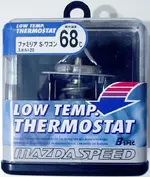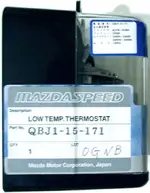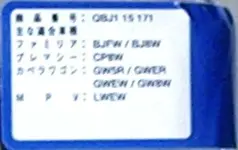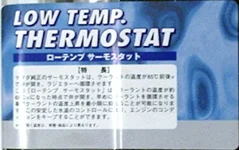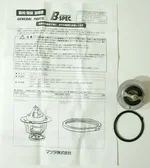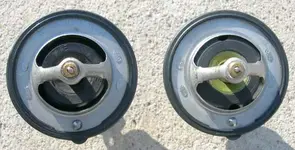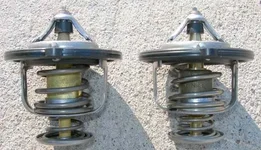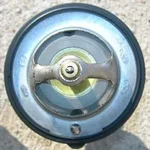I just installed the MazdaSpeed low temp thermostat yesterday while I was doing my timing belt... this thermostat is designed to reduce the engine operating temperature so that it will less likely be heat soaked during hard driving while also being emissions legal (in Japan). This thermostat is very expensive (overpriced), it retails for 80 bucks in Japan!
The stock thermostat starts to open at 82 degrees celcius, while the ms one starts to open at 68 degrees celcius... a difference of 14 degrees!
The thermostat I installed was obviously QBJ1-15-171 since I have the FS engine. It is compatible with the FS, FP, K series, and RF diesel engines (both turbo and non-turbo). There's another thermostat MazdaSpeed sells that is compatible (part number QNB1-15-171, it is a bit cheaper... by 10 bucks) with the B series engines (they do not recommend using it with the B3 engine since it doesn't make all that much heat to begin with, so you'll end up overcooling it!), Z5, ZM, and ZL engines.
After I installed it, I did some data logging through the OBD-II port to see what the coolant temps are now at.... ambient temperature is about 35 degrees celcius today... the data logging starts from cold starting the engine and waiting for it to be in the, "operating temperature" range (temp gauge at middle), the coolant sensor is reading at a steady 75 degrees celcius even with some driving in the first 10 minutes of start up. This shows the thermostat is just at the threshold point (it's regulating the coolant temp to that level) while the coolant sensor is seeing 75 degrees at the hottest point of the cooling system. After waiting for the engine to be truely warmed up (through some highway cruising), the temperature peaks out to about 85 degrees at idle (with A/C on). Driving around streets, the temperature stays steady between 80 to 81 degrees. Highway cruising between 65-75mph results in a steady 83 degrees. Hard "spirited" driving bumps the coolant temperatures up to 87 degrees. Not bad!
So what is the real result? The engine bogs less now in the "spring" 95 degree fahrenheit texas heat, its making power at the upper RPM ranges like it should, and the engine does *not* run "too cold".
Compared with before (back when the car was still pretty stock):
-about 25 degrees celcius ambient temperature (guessing)
-Intake temp sensor reading about 40 degrees celcius
-50mph crusing... about 95 degrees celcius
-sitting at idle at the light.... about 100 degrees celcius (for you people still in the stone ages, that's 212 degrees fahrenheit, which is boiling at sea level... but that's not boiling in the radiator since its pressurized to 16psi)
So while the engine wasn't overheating, it was already heat soaking and reducing optimal power. This will get worse when you add more load to the cooling system obviously, especially a turbo!
As for extra info, using 93 octane gas and ZFR6F-11 extended reach plugs (just installed), the timing advance peaks out at 63.5 degrees (it would be less with lower octane gas from what I saw a few years ago when I last data logged)... and with my HKS intake and FS-ZE parts, the MAF reading peaks out at about 82 grams per second airflow. The intake temp averages about 60 degrees celcius since 1) it's not 100% accurate, 2) the intake sits in the engine bay and is not a "cold air intake"
So was it worth paying so much money for this thermostat? Hell yeah! Is it overpriced? Of course it is! But this thermostat has proven that the stock radiator can still adequately cool in hot weather which makes this thermostat a "cheap" cooling system upgrade (yeah a $400 radiator is not cheap and most people don't need it).
Hopefully this data will discern any skeptics about installing a lower temperature thermostat (that's Mazda approved) increasing emissions, reducing efficiency, engine running richer (in fact it doesn't, the fuel trim level is about the same as before), etc.
But this thread is worthless without pics right?
The stock thermostat starts to open at 82 degrees celcius, while the ms one starts to open at 68 degrees celcius... a difference of 14 degrees!
The thermostat I installed was obviously QBJ1-15-171 since I have the FS engine. It is compatible with the FS, FP, K series, and RF diesel engines (both turbo and non-turbo). There's another thermostat MazdaSpeed sells that is compatible (part number QNB1-15-171, it is a bit cheaper... by 10 bucks) with the B series engines (they do not recommend using it with the B3 engine since it doesn't make all that much heat to begin with, so you'll end up overcooling it!), Z5, ZM, and ZL engines.
After I installed it, I did some data logging through the OBD-II port to see what the coolant temps are now at.... ambient temperature is about 35 degrees celcius today... the data logging starts from cold starting the engine and waiting for it to be in the, "operating temperature" range (temp gauge at middle), the coolant sensor is reading at a steady 75 degrees celcius even with some driving in the first 10 minutes of start up. This shows the thermostat is just at the threshold point (it's regulating the coolant temp to that level) while the coolant sensor is seeing 75 degrees at the hottest point of the cooling system. After waiting for the engine to be truely warmed up (through some highway cruising), the temperature peaks out to about 85 degrees at idle (with A/C on). Driving around streets, the temperature stays steady between 80 to 81 degrees. Highway cruising between 65-75mph results in a steady 83 degrees. Hard "spirited" driving bumps the coolant temperatures up to 87 degrees. Not bad!
So what is the real result? The engine bogs less now in the "spring" 95 degree fahrenheit texas heat, its making power at the upper RPM ranges like it should, and the engine does *not* run "too cold".
Compared with before (back when the car was still pretty stock):
-about 25 degrees celcius ambient temperature (guessing)
-Intake temp sensor reading about 40 degrees celcius
-50mph crusing... about 95 degrees celcius
-sitting at idle at the light.... about 100 degrees celcius (for you people still in the stone ages, that's 212 degrees fahrenheit, which is boiling at sea level... but that's not boiling in the radiator since its pressurized to 16psi)
So while the engine wasn't overheating, it was already heat soaking and reducing optimal power. This will get worse when you add more load to the cooling system obviously, especially a turbo!
As for extra info, using 93 octane gas and ZFR6F-11 extended reach plugs (just installed), the timing advance peaks out at 63.5 degrees (it would be less with lower octane gas from what I saw a few years ago when I last data logged)... and with my HKS intake and FS-ZE parts, the MAF reading peaks out at about 82 grams per second airflow. The intake temp averages about 60 degrees celcius since 1) it's not 100% accurate, 2) the intake sits in the engine bay and is not a "cold air intake"
So was it worth paying so much money for this thermostat? Hell yeah! Is it overpriced? Of course it is! But this thermostat has proven that the stock radiator can still adequately cool in hot weather which makes this thermostat a "cheap" cooling system upgrade (yeah a $400 radiator is not cheap and most people don't need it).
Hopefully this data will discern any skeptics about installing a lower temperature thermostat (that's Mazda approved) increasing emissions, reducing efficiency, engine running richer (in fact it doesn't, the fuel trim level is about the same as before), etc.
But this thread is worthless without pics right?

